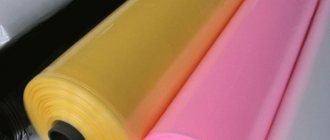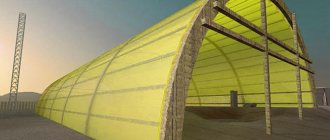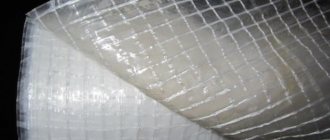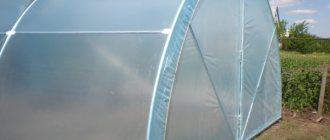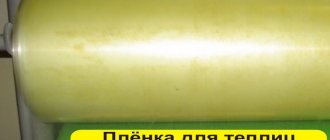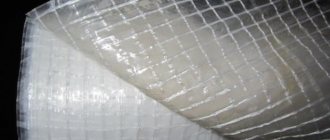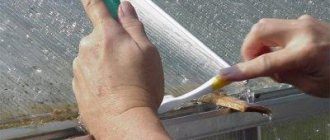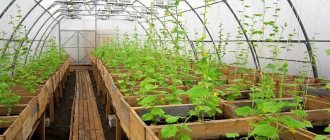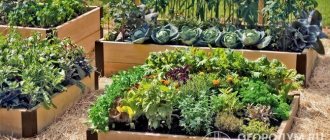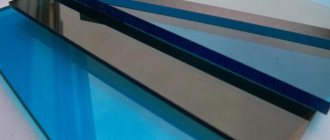The question of choosing a covering material for a greenhouse always worries summer residents. However, many people prefer film. Experts recommend reinforced film for greenhouses, which is considered one of the best covering materials. It is distinguished by high quality and a number of other advantages. At the same time, the material has a low cost, which distinguishes it from similar products.
Photo: https://koffkindom.ru/
Content:
- Reinforced polyethylene film 2x10m 200µm ZZP covering, for greenhouses, greenhouses, light-stabilized, food grade, light transmission 81%, mesh cell 12x12mm
- Reinforced greenhouse film 2x25m 140g/sq.m 200mkr TDStels
- Reinforced greenhouse film 2x50m 120g/sq.m 200mkr TDStels
- Reinforced film 120 MKR - (2X12 M)
- Reinforced greenhouse film 140g/sq.m. (2x50m) 200 microdistrict TDStels
- Reinforced greenhouse film 2x20m 120g/sq.m 200mkr TDStels
- Reinforced film 150 MKR - (2X12 M)
- Reinforced film 400 microns
- Reinforced film 120 g (4x50)
- Reinforced film 100 g (2x25)
- Which reinforced film is best to use for a greenhouse?
Reinforced greenhouse film 2x25m 140g/sq.m 200mkr TDStels
Photo: beru.ru
The product is characterized by flexibility and fairly high elasticity rates, which makes it easy to lay film material with a reinforcing layer on the surface of any relief. The high strength of reinforced material determines the rationality and efficiency of its use. If you are concerned about the question of how to choose reinforced film for greenhouses, then in this case it is the strength of the material that is the determining factor.
Reinforced greenhouse film 2x25m 140g/sq.m 200mkr TDStels
Pros:
- UV resistance
- high strength
- rot resistance
- weather resistance
- environmental friendliness
- creating a microclimate
- possibility of quick repair
- ease of storage
- density 140 g/m2
- guarantee
- certificates
Advantages of Largush film greenhouses
|
|
|
|
|
|
|
|
Reinforced greenhouse film 2x50m 120g/sq.m 200mkr TDStels
Photo: beru.ru
Reinforced film is presented on the market by Russian and foreign manufacturers. The product is characterized by high performance and quality properties. In demand as a covering and waterproofing material. Still unsure which reinforced film to choose for greenhouses? We recommend choosing the TDStels product.
Reinforced greenhouse film 2x50m 120g/sq.m 200mkr TDStels
Pros:
- UV resistance
- high strength
- rot resistance
- weather resistance
- environmental friendliness
- creating a microclimate
- possibility of quick repair
- ease of storage
- density 120 g/m2
- guarantee
- certificates
- all types of payment
Reinforced film, reinforced tarpaulin and other types of covering awnings
The process of growing vegetables and berries can be divided into two stages: building a greenhouse and caring for the plants during their growth. Whether you will be able to enjoy spring strawberries, and whether crispy cucumbers will appear on the table, largely depends on how and from what material the greenhouse will be built. The reinforced covering material used by gardeners - reinforced film, reinforced awning or special tarpaulin - creates the most comfortable conditions for greenhouse plants. Covering material: what type of material to choose for beds (read more)
Reinforced film is a three-layer material, where a mesh frame made of lavsan is laid between two layers of polyethylene.
Reinforced film 120 MKR - (2X12 M)
Photo: beru.ru
The product is used for installing greenhouses and greenhouses; it is durable and highly durable, which is ensured by its multi-layer structure. In the production of the film, traditional polyethylene is used, as well as a metal reinforcing layer, which increases the wear resistance of the product. Available in transparent and opaque versions. If you are concerned about the question of where to buy reinforced film for a greenhouse, then we recommend placing your bet on the online store beru.ru.
Reinforced film 120 MKR - (2X12 M)
Pros:
- UV resistance
- high strength
- rot resistance
- weather resistance
- possibility of quick repair
- ease of storage
- transparent
- density 120 microns
Main characteristics of reinforced films
For a long time, polyethylene film was the only covering material for greenhouses. It met many requirements, but after one year of use it became cloudy and transmitted light much worse. And most often it was impossible to maintain the integrity of the canvas during one season; it was easily damaged even with minor mechanical stress.
Reinforced polyethylene film has very high strength, which is achieved by weaving a special mesh into the polyethylene
The reinforcing film for greenhouses that appeared on the market has practically replaced conventional polyethylene. It has not lost any of the technical characteristics of this material, and it eliminates the main disadvantages of conventional polyethylene.
The reinforced fabric is a frame in the form of a mesh, onto which a polyethylene film is fused on both sides. It is the presence of a dense mesh that allows this material to be used as a reliable covering covering and gives it a number of significant positive characteristics. Advantages of reinforced film:
- resistant to stretching, withstands significant mechanical damage;
- has hydro- and vapor barrier properties;
- withstands significant temperature fluctuations (from –30 to 90 °C);
- durable in use (5 years or more).
This material is resistant to ultraviolet radiation and can withstand difficult weather conditions, characterized by strong, even squally, wind, precipitation in the form of showers and hail.
All reinforced film for greenhouses has the following structure: three layers, one of which is reinforced, and the other two serve for light stabilization
Reinforced film, reinforced PE and membrane: material properties
Several types of reinforced film are produced. They differ both in the composition and size of the frame weaving, and in the quality of the deposited polyethylene layers. The frame is made by weaving threads that are created from the following materials:
- fiberglass;
- polyethylene (PE);
- polypropylene.
The thickness of the threads varies, which affects the strength and weight of the reinforced film. Cells may also vary in size. A film with large elements is more light-transmitting; small sizes increase the strength of the covering material. In gardening, they mainly use film with a cell size of 1.5x1.5 cm. This format provides optimal comfortable conditions for plants in greenhouses and greenhouses.
Most of the load that acts on the film is absorbed by the reinforced layer, which makes it strong and reliable.
Films fused onto the frame differ in thickness, density and additives that improve the functional characteristics of the material. Additives provide the following properties of greenhouse films:
- Hydrophilic. They prevent the formation of drops of condensation on the inside of the film, which would inevitably fall down onto the plants. Moisture flows down the walls of the greenhouse.
- Antistatic. These additives help repel dust from the outside of the film, preventing the formation of a layer of dirt that will impede the penetration of light.
- Heat-protective. They prevent the release of heat accumulated inside the greenhouse.
- Light-stabilizing. Protect the film from destruction under the influence of sunlight.
There are also membrane films, that is, having microscopic holes in each cell through which air penetrates into the greenhouse - the so-called “breathing” films.
The form of release of reinforced film is roll. The length of standard rolls is 10, 25 and 50 m. Sometimes there are rolls 100 m long. The width of the film can be 2, 3, 4 or 6 m. When wound into a roll, for ease of transportation, the wide fabric is folded: 3-4 meter - in half, the height of the bundles is 1.5 or 2 m, respectively; 6-meter film is folded in three, as a result of which the height of the roll reaches 2 m. The sheets are hermetically packed, and there must be a sheet with the characteristics of the product inside.
Reinforced film is available in rolls
Helpful advice! When purchasing a roll of reinforced film, you must pay attention to the integrity of the packaging. If it is damaged, there is a high probability that there are defects in the material itself.
What can be reinforced with reinforcing film
The scope of application of reinforced film is extensive. It is used wherever there is a need to build temporary premises, to shelter a structure, materials, objects, openings or plants from precipitation, moisture penetration, winds, low or high temperatures. The main areas where reinforced film is used:
- Industrial and private gardening and vegetable gardening. It is a covering material for greenhouses and greenhouses; temporary vegetable storage facilities, sheds, and silage pits are constructed from this film.
- Industry and construction. Reinforced polyethylene fabric is used to make warehouses of lightweight structures, cover unfinished objects, preserve equipment in production workshops, make fences for temporary landfills, and lay them on the floor as waterproofing. As a waterproof material, the film is used when performing roofing work.
- Life The film is suitable for protecting furniture, electrical equipment and other household items from moisture and low temperatures. It is used in the arrangement of decorative ponds, to protect against the penetration of cold air and moisture into the room through wooden window frames, for waterproofing wooden structures and floorings.
Reinforcing film can be used to cover an unfinished object
The active use of reinforced film in various areas of production and everyday life is facilitated by its elasticity, flexibility and low weight. Fixing, dismantling and transporting this material is not difficult; working with film does not require complex and expensive tools, and no special skills are required.
What you need to know when choosing reinforced film for greenhouses
Before covering the greenhouse with film, it is necessary to carefully calculate the dimensions of the covering sheet. Turns and bends should be calculated taking into account the features of the frame structure. Reinforced film does not stretch; it cannot be stretched even 1–2 cm.
Particular attention should be paid to color. To create optimal conditions for plants, it is better to choose white film. It retains sunlight the least (light transmittance - 85%). If we take into account that reinforcement already significantly reduces this indicator, then when using green or blue film, you need to be prepared to reduce illumination by another 5-7%. You can purchase colored coating only if the types of crops for which such conditions are acceptable are planted in greenhouses.
When using green reinforced greenhouse film, you need to be prepared for an 80% reduction in light transmission
For light-loving plants, it is necessary to choose a film with large cells of 1.5x1.5 or 2x2 cm.
A significant indicator is density. The strength of the material, durability of use and price depend on it. Traditionally, materials from 120 to 200 microns are chosen for greenhouses.
Helpful advice! When purchasing reinforced film for greenhouses, do not rely only on the information (regarding density) posted in the product card of an online store or heard from a sales consultant. Be sure to request a product quality certificate, which will contain accurate data. It is impossible to determine the density of reinforced film visually and by touch, and unscrupulous sellers often take advantage of this.
The main characteristics that you should pay attention to when purchasing reinforced film:
- cell sizes;
- color;
- density;
- the presence of additives that enhance the consumer properties of the film (hydrophilic, light-stabilizing, antistatic).
Reinforced film for greenhouses is represented on the modern market by both domestic and imported products
Often preference is given to reinforced film 200 microns. It belongs to the middle price segment, can withstand significant mechanical loads, and is easy to work with. However, you can purchase reinforced film 400 microns for the greenhouse. The price of such material is slightly higher - by 3-4% relative to the cost of film with a density of 200 microns.
If you cut out blanks from fabric, glue them hot (using a soldering iron or a blowtorch) or cold using adhesives, you will get a greenhouse cover made of reinforced film 400 microns, which is convenient to put on the frame at the beginning of the season and remove at the end of it. You won’t have to waste time on laying or fixing the canvas, and there will be no risk of damaging it during fastening.
Reinforced film for greenhouses: consumer reviews and advice from practitioners
Before equipping a greenhouse, it would be useful to get acquainted with the opinions of those who have already used the film. Not a single instruction takes into account all the subtleties and nuances that arise during practical application.
Higher density reinforced film is more durable
“Leno film, 170 microns. This year I covered it for the second time. It’s normal, the light transmission didn’t get any worse. I have a rectangular greenhouse, and I always had problems with the canvas sagging. Not so with this one: just as you secured it, it sits there – no depressions.”
Semyon, Voronezh
“Film with a rigid mesh, ideal. True, the frame had to be corrected. I cut the straight lines, and the curvature of the nailed slats immediately began to appear. But now I’m happy myself: the greenhouse is excellent. The mesh refracts the sun's rays, and the heat inside is not burning, but soft, moderate. So far, cucumbers, lettuce, and radishes are developing normally. Well spent the money"
Nikolay Fokin, Yaroslavl
“I heard the opinion that after a year of use, the reinforced mesh remains intact, but the film crumbles. Nothing has been damaged in two seasons, and this cannot happen unless the mesh is holed. I’m satisfied with the condition of the material, I’m sure that I will use this film for the third season (and maybe more).”
Kristina Silina, Belgorod
In some reviews, users give advice that is worth listening to.
Reinforced film for greenhouses, the price of which is in the average price range, can last from 3 to 6 years
“I have a 200 micron reinforced film on my greenhouse. Strong, in two years it has not torn at all. The greenhouse is large, almost 30 square meters. I also prepared some tape for patching, but it wasn’t needed. True, he himself made a mistake. The frame was made of wood, and the film was nailed down with a furniture stapler. Staples every one and a half centimeters. When I took them off, I made holes. This is in the first year of use. And this season I put the tape that is used to pack boxes with heavy equipment and punched the film through it. It’s more reliable, and I won’t make any holes when I take it off. Or you can just put a film of dense polyethylene on it.”
Alexander, Yaroslavl
The main disadvantages indicated in individual reviews mainly relate to the fragility of use.
“This reinforced film is definitely not worth that much money. When I pulled the polyethylene on, I at least knew that it was for a year. And here they promised at least 3 seasons. After the first one you already want to throw it away! Full of holes, dirty.”
Valery, Gukovo
Related article:
Covering material for beds: a good harvest without unnecessary hassle
Varieties, recommendations for selection for different types of soil and plants. Practical benefits and application. Tips for choosing brands. Examples of operation.
“I didn’t like the reinforced film. In cloudy weather, the greenhouse is generally grey. And it's not durable at all. There was a strong wind, branches were flying, still without leaves, since it was early spring. We often have dry winds at this time of year. There are plenty of holes. I can’t say that the cells are really empty, but there are a lot of punctures. The density is not the highest - 120 microns, but I expected better. I don't know what will happen before the end of the season. Disappointed."
Anna, Lipetsk
To create greenhouses, the film density should be in the range from 120 to 1200 g/m²
Opinions, of course, are different, but mostly positive. Based on reviews (from practical application experience), we can conclude that with proper use, i.e., taking into account the characteristics of this material, the reinforced film still confirms the declared qualities and guaranteed service life of 3–5 years.
Reinforced film in industry: the purpose of construction covering awnings
Another fairly wide area of application for reinforced film is construction. Having started a project from scratch, it is almost impossible to complete it during the spring-summer period. Stored materials and open spaces need protection from autumn precipitation and winter cold. And this function is performed by construction awnings.
If there is a need to cover a small amount of building materials or a small room, you can purchase film and make an awning yourself. It is worth buying film with a density of 120 microns. If the awning will be used as a shelter for a room for a short time, the film material can simply be pressed with heavy objects, but always with a smooth surface so as not to damage the polyethylene layer. When covering building materials, it is easy to tighten the bottom of the awning with vinyl packing tape.
Reinforced film is used as a waterproofing material when performing roofing and facade work, to protect walls and foundations
It is convenient to use construction awnings with eyelets. Ready-made versions are always produced with holes into which a rope or rope can easily be threaded. You can install eyelets yourself by purchasing them at a specialized store. And if the awning is small in size and you need small eyelets, they can be purchased in the department of the shopping center where sewing accessories are sold.
When choosing a construction awning, you need to consider the following factors:
- intensity and duration of use;
- what weather conditions will affect the material;
- Is it necessary to have fixing elements?
Based on the above factors, the density and dimensions of the material are selected.
A balanced approach to selection will allow you to save as much money as possible and get the expected result.
Reinforced greenhouse film 140g/sq.m. (2x50m) 200 microdistrict TDStels
Photo: beru.ru
Reinforced polyethylene film has decent performance qualities. It has high light transmittance, as well as low vapor and moisture permeability. The product is also resistant to fungi and mold. The product is also resistant to deformation and durable if you follow the operating rules correctly.
Reinforced greenhouse film 140g/sq.m. (2x50m) 200 microdistrict TDStels
Pros:
- UV resistance
- high strength
- rot resistance
- weather resistance
- environmental friendliness
- creating a microclimate
- possibility of quick repair
- ease of storage
- density 140 g/m2
- guarantee
- certificates
- all types of payment
Reinforced greenhouse film 2x20m 120g/sq.m 200mkr TDStels
Photo: beru.ru
The material is able to withstand heavy mechanical loads, as well as changes in air temperature ranging from -40 to +90 degrees. It can be used not only for the construction of greenhouses and greenhouses, but also for arranging temporary canopies, during the construction of artificial reservoirs, when carrying out facade, landscape and other construction work. Also, TDStels brand material can be used as packaging for goods of any size.
Reinforced greenhouse film 2x20m 120g/sq.m 200mkr TDStels
Pros:
- UV resistance
- high strength
- rot resistance
- weather resistance
- environmental friendliness
- creating a microclimate
- possibility of quick repair
- ease of storage
- density 120 g/m2
- guarantee
- certificates
- all types of payment
Reinforced film, reinforced PE and membrane: material properties
Several types of reinforced film are produced. They differ both in the composition and size of the frame weaving, and in the quality of the deposited polyethylene layers.
The frame is made by weaving threads that are created from the following materials:
- fiberglass;
- polyethylene (PE);
- polypropylene.
The thickness of the threads varies, which affects the strength and weight of the reinforced film. Cells may also vary in size. A film with large elements is more light-transmitting; small sizes increase the strength of the covering material. In gardening, they mainly use film with a cell size of 1.5x1.5 cm. This format provides optimal comfortable conditions for plants in greenhouses and greenhouses.
Most of the load that acts on the film is absorbed by the reinforced layer, which makes it strong and reliable.
Films fused onto the frame differ in thickness, density and additives that improve the functional characteristics of the material.
Additives provide the following properties of greenhouse films:
- Hydrophilic. They prevent the formation of drops of condensation on the inside of the film, which would inevitably fall down onto the plants. Moisture flows down the walls of the greenhouse.
- Antistatic. These additives help repel dust from the outside of the film, preventing the formation of a layer of dirt that will impede the penetration of light.
- Heat-protective. They prevent the release of heat accumulated inside the greenhouse.
- Light-stabilizing. Protect the film from destruction under the influence of sunlight.
There are also membrane films, that is, having microscopic holes in each cell through which air penetrates into the greenhouse - the so-called “breathing” films.
The form of release of reinforced film is roll. The length of standard rolls is 10, 25 and 50 m. Sometimes there are rolls 100 m long. The width of the film can be 2, 3, 4 or 6 m. When wound into a roll, for ease of transportation, the wide fabric is folded: 3-4 meter - in half, the height of the bundles is 1.5 or 2 m, respectively; 6-meter film is folded in three, as a result of which the height of the roll reaches 2 m. The sheets are hermetically packed, and there must be a sheet with the characteristics of the product inside.
Reinforced film is produced in rolls.
On a note! When purchasing a roll of reinforced film, you must pay attention to the integrity of the packaging. If it is damaged, there is a high probability that there are defects in the material itself.
Reinforced film 150 MKR - (2X12 M)
Photo: beru.ru
A high-quality innovative product is characterized by the highest strength and transparency, therefore it is ideal for growing any plants in a greenhouse. The film is characterized by resistance to wear and mechanical damage. Does not rot and resists mold formation. The cost of the product is affordable, and installation is so simple that you can do it yourself.
Reinforced film 150 MKR - (2X12 M)
Pros:
- UV resistance
- high strength
- rot resistance
- weather resistance
- possibility of quick repair
- ease of storage
- transparent
- density 150 microns
Pros and cons of covering a greenhouse with film.
Positive aspects : Reinforced film is an extremely inexpensive option compared to other materials (polycarbonate, etc.). The cheapest is transparent film without additives that stabilize light penetration.
The film is easy to install. In calm weather, even one person can apply it to the frame without assistance. No specific skills are required for construction.
The tape is elastic and will fit any curved greenhouse. This is another advantage over glass and polycarbonate materials (in theory, polycarbonate can be bent, but there is a high risk of cracking, which will lead to inevitable breakage).
The tape does not allow moisture to pass through both outside and inside. When it’s hot, the greenhouse will maintain optimal soil moisture. Acceptable light transmittance helps plants receive proper sunlight (sunlight is scattered through the film, the plants do not burn).
In addition, reinforced film can be easily repaired using tape or a patch.
You don’t have to remove the film from the greenhouse frame, if the material is higher than 100g/m2 in density, it can easily withstand the weight of snow.
Negative aspects : Depending on the density, the film will not last for a relatively long time (one season at low density, 3-5 seasons at high density. Despite being equipped with components that are resistant to ultraviolet radiation, it in any case reduces the service life of the film.
If condensation appears inside the greenhouse, to prevent this problem it is suggested to ventilate the greenhouse more often.
Reinforced film 400 microns
Photo: beru.ru
This is a chemically neutral polymer material with a 3-layer structure with a reinforced frame mesh layer and outer layers of light-stabilized polyethylene. The product has increased strength, stability in different climatic conditions, and resistance to mechanical stress.
Reinforced film 400 microns
Pros:
- UV resistance
- high strength
- rot resistance
- weather resistance
- environmental friendliness
- creating a microclimate
- possibility of quick repair
- ease of storage
- density 140 g/m2
- guarantee
- certificates
Reinforced film for greenhouses: consumer reviews and advice from practitioners
Before equipping a greenhouse, it would be useful to get acquainted with the opinions of those who have already used the film. Not a single instruction takes into account all the subtleties and nuances that arise during practical application.
Reinforced film with a higher density is more durable.
Semyon, Voronezh.
“Leno film, 170 microns. This year I covered it for the second time. It’s normal, the light transmission didn’t get any worse. I have a rectangular greenhouse, and I always had problems with the canvas sagging. Not so with this one: just as you secured it, it sits there – no depressions.”
Nikolay Fokin, Yaroslavl.
“Film with a rigid mesh, ideal. True, the frame had to be corrected. I cut the straight lines, and the curvature of the nailed slats immediately began to appear. But now I’m happy myself: the greenhouse is excellent. The mesh refracts the sun's rays, and the heat inside is not burning, but soft, moderate. So far, cucumbers, lettuce, and radishes are developing normally. Well spent the money"
Kristina Silina, city
“I heard the opinion that after a year of use, the reinforced mesh remains intact, but the film crumbles. Nothing has been damaged in two seasons, and this cannot happen unless the mesh is holed. I’m satisfied with the condition of the material, I’m sure that I will use this film for the third season (and maybe more).”
In some reviews, users give advice that is worth listening to.
Reinforced film for greenhouses, the price of which is in the average price range, can last from 3 to 6 years.
Alexander, Yaroslavl.
“I have a 200 micron reinforced film on my greenhouse. Strong, in two years it has not torn at all. The greenhouse is large, almost 30 square meters. I also prepared some tape for patching, but it wasn’t needed. True, he himself made a mistake. The frame was made of wood, and the film was nailed down with a furniture stapler. Staples every one and a half centimeters. When I took them off, I made holes. This is in the first year of use. And this season I put the tape that is used to pack boxes with heavy equipment and punched the film through it. It’s more reliable, and I won’t make any holes when I take it off. Or you can just put a film of dense polyethylene on it.”
The main disadvantages indicated in individual reviews mainly relate to the fragility of use.
Valery, Gukovo.
“This reinforced film is definitely not worth that much money. When I pulled the polyethylene on, I at least knew that it was for a year. And here they promised at least 3 seasons. After the first one you already want to throw it away! Full of holes, dirty.”
Anna, Lipetsk.
“I didn’t like the reinforced film. In cloudy weather, the greenhouse is generally grey. And it's not durable at all. There was a strong wind, branches were flying, still without leaves, since it was early spring. We often have dry winds at this time of year. There are plenty of holes. I can’t say that the cells are really empty, but there are a lot of punctures. The density is not the highest - 120 microns, but I expected better. I don't know what will happen before the end of the season. Disappointed."
To create greenhouses, the film density must be in the range from 120 to 1200 g/m².
Opinions, of course, are different, but mostly positive. Based on reviews (from practical application experience), we can conclude that with proper use, i.e., taking into account the characteristics of this material, the reinforced film still confirms the declared qualities and guaranteed service life of 3–5 years.
Reinforced film 120 g (4x50)
Photo: beru.ru
This current and popular high-density material is perfect for covering greenhouse frames. The film is also suitable for long-term covering of materials stored in the open air.
Reinforced film 120 g (4x50)
Pros:
- UV resistance
- high strength
- rot resistance
- weather resistance
- possibility of quick repair
- ease of storage
- White color
- size 4x50 m
- density 120 g/m2
Reinforcing film: additional information for demanding customers
Sometimes it can be difficult to understand the quality of a product. You receive convincing information from the seller, purchase a product, but it breaks, breaks, or fails much earlier than the warranty period expires.
When purchasing reinforced film, it is important to pay attention to its color; for use in greenhouses, the material must be white.
When purchasing reinforced film for greenhouses, a pitfall may be the use of not primary, but secondary raw materials. How can you find out? You need to understand this issue yourself: not a single sales manager will share such information, even if he owns it. Don't be tempted by a cheap product unless it is marked as an economy offer. Read the information about the film carefully.
Be sure to read the manufacturer's information (address and telephone numbers), product dimensions, technical specifications, including a description of the composition, density and other characteristics, taking into account additives. If, based on the information, it was not possible to get a complete picture of the product, it is most likely not certified, therefore, you can forget about quality guarantees.
For those who plan to buy a tarpaulin awning, it would be useful to have the following information. When cutting fabric to make an awning, two technologies are used, more precisely, two dimensions are taken into account. The first option is when the final size is official, i.e. if the parameters of the finished product are indicated. Such awnings are sold under the Tarpiks brand.
Density is one of the most important parameters that you should pay attention to when choosing reinforced film.
The second type of designation of official dimensions is by cutting the canvas, i.e. The size of the blanks is indicated on the awning. Naturally, the fabric bends, some of it goes to the seams. These are Tarpaulin awnings. If you purchased material with dimensions of 3x4 m, but it turns out that the sides are 20 cm smaller, this is not a hoax - this is a designation method. It is recommended to take into account the size difference before purchasing the product.
You can list the positive characteristics and disadvantages of waterproof and vapor barrier reinforced film. You can talk about quality and disagree with the methods of designating sizes, preferring imported or domestic goods. But two undeniable advantages of reinforced film cannot be denied: it makes a reliable shelter, and the process of laying the material becomes much simpler.
Reinforced film 100 g (2x25)
Photo: beru.ru
Reliable film material consists of 3 layers. It has high strength, reliability and durability. Supplied in convenient rolls, one product can cover an area of 50 m2. It has an attractive price and guarantees the highest quality.
Reinforced film 100 g (2x25)
Pros:
- UV resistance
- high strength
- rot resistance
- weather resistance
- possibility of quick repair
- ease of storage
- transparent
- White color
- size 2x25 m
- density 100 g/m2
Reinforced film in industry: the purpose of construction covering awnings
Another fairly wide area of application for reinforced film is construction. Having started a project from scratch, it is almost impossible to complete it during the spring-summer period. Stored materials and open spaces need protection from autumn precipitation and winter cold. And this function is performed by construction awnings.
If there is a need to cover a small amount of building materials or a small room, you can purchase film and make an awning yourself. It is worth buying film with a density of 120 microns. If the awning will be used as a shelter for a room for a short time, the film material can simply be pressed with heavy objects, but always with a smooth surface so as not to damage the polyethylene layer. When covering building materials, it is easy to tighten the bottom of the awning with vinyl packing tape.
Reinforced film is used as a waterproofing material when performing roofing and facade work, to protect walls and foundations.
It is convenient to use construction awnings with eyelets. Ready-made versions are always produced with holes into which a rope or rope can easily be threaded. You can install eyelets yourself by purchasing them at a specialized store. And if the awning is small in size and you need small eyelets, they can be purchased in the department of the shopping center where sewing accessories are sold.
When choosing a construction awning, you need to consider the following factors:
- intensity and duration of use;
- what weather conditions will affect the material;
- Is it necessary to have fixing elements?
Based on the above factors, the density and dimensions of the material are selected.
A balanced approach to selection will allow you to save as much money as possible and get the expected result.
Which reinforced film is best to use for a greenhouse?
Photo: https://www.elitfasad31.ru/
When faced with the dilemma of choosing a covering material for a greenhouse, it is necessary to pay special attention to the quality and performance characteristics of the product. Experts recommend giving priority consideration to the following characteristics:
- light scattering
- permeability of oxygen and carbon dioxide
- ultraviolet permeability;
- ability to retain heat;
- moisture and frost resistance;
- tensile strength;
- durability;
- elasticity;
- transparency;
- antistatic;
- weather resistance.
Along with this, the covering material should not sag or stretch greatly under the influence of precipitation. So if you want to get a good harvest every year, then you need to pay close attention to the recommendations of experts and approach the choice of covering material with all responsibility. Well, our review will provide you with all the necessary assistance.
#Top 10
Read us first - add the site to your favorite sources.
Add a comment
{"commentics_url":"\/\/express-novosti.ru\/comments\/","page_id":1436259,"enabled_country":false,"enabled_state":false,"state_id":0,"enabled_upload": false,"maximum_upload_amount":3,"maximum_upload_size":5,"maximum_upload_total":5,"securimage":true,"securimage_url":"\/\/express-novosti.ru\/comments\/3rdparty\/securimage\ /securimage_show.php?namespace=cmtx_1436259″,”lang_error_file_num”:”\u041c\u0430\u043a\u0441\u0438\u043c\u0443\u043c %d \u0444\u0430\u0439\u043b\u043e\ u0432\u043c\u043e\ u0436\u0435\u0442 \u0431\u044b\u0442\u044c \u0437\u0430\u0433\u0440\u0443\u0436\u0435\u043d\u043e.","lang_error_file_size":"\u041f\u043e \u0436\u0430\u043b\ u0443\u0439\u0441\u0442\u0430, \u0437\u0430\u0433\u0440\u0443\u0437\u0438\u0442\u0435 \u0444\u0430\u0439\u043b \u0440\u0430\ u0437\u043c\u0435\u0440\u043e \u043c \u043d\u0435 \u0431\u043e\u043b\u0435\u0435 %d MB.","lang_error_file_total":"\u041e\u0431\u0449\u0438\u0439 \u0440\u0430\u0437\u043 c\u0435\u0440\ u0432\u0441\u0435\u0445 \u0444\u0430\u0439\u043b\u043e\u0432 \u0434\u043e\u043b\u0436\u0435\u043d \u0431\u044b\u0442\u044c \ u043d\u0435\u0431\u043e\u043b\ u0435\u0435 %d MB.","lang_error_file_type":"\u041c\u043e\u0436\u043d\u043e \u0437\u0430\u0433\u0440\u0443\u0436\u0430\u0442\u044c \u0442\u0 43e\u043b\u044c ""lang_text_loading":" u0437\u043a\u0430 ..","lang_placeholder_state":"\u0420\u0435\u0433\u0438\u043e\u043d","lang_text_country_first":"\u0421\u043d\u0430\u0447\u0430\u043b\u0430 \u0432\u044b\u04 31\u0435 \u0440\u0438\u0442\u0435 \u0441\u0442\u0440\u0430\u043d\u0443″,”lang_button_submit”:”\u0414\u043e\u0431\u0430\u0432\u0438\u0442\u04 4c","lang_button_preview":" \u041f\u0440\u0435\u0434\u0432\u0430\u0440\u0438\u0442\u0435\u043b\u044c\u043d\u044b\u0439 \u043f\u0440\u043e\u0441\u043c\u 043e\u0442\u0440″,”lang_button_remove ":"\u0423\u0434\u0430\u043b\u0438\u0442\u044c","lang_button_processing":"\u041f\u043e\u0434\u043e\u0436\u0434\u0438\u0442\u0435..."}
Greenhouse structure
Despite the high strength of the film, it should be installed very carefully. This will avoid serious mistakes and damage to the material. First you need to make sure that the frame does not have sharp corners or protruding elements that can damage the film. All parts of the greenhouse that come into contact with the covering material must have a smooth surface. In addition, the frame should be painted white. This will protect the film from excessive overheating and destruction.
Laying the canvas on the frame is quite simple:
- First you need to find 2 slats. It is better that they are equal to the length of the building.
- The lath should be placed on the free edge of the film, and then wrapped so that the tree is not visible.
- Now the canvas should be fixed to the wooden element with a stapler.
- The rail should be laid on one side of the greenhouse and secured to the frame with self-tapping screws.
- The roll is thrown to the other side of the building. The film is then stretched.
- Next, you need to measure the required amount of material with a reserve and attach the canvas on the other side.
To ensure reliable fixation of the canvas, it is attached to the ribs using staples.
